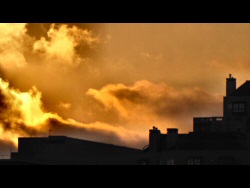Cause and Effect of Felling City Trees
June 4, 2010 -- While we realize there are many ways
for trees to die such as lightning strikes, wind, disease and insect
infestation; the cutting down of healthy trees can have tragic
consequences to the natural ecology as well as the environment as a
whole. Large city blocks with small to average sized apartment buildings
surrounding large courtyards in the middle of such a blocks, are
becoming rare in San Francisco.
|
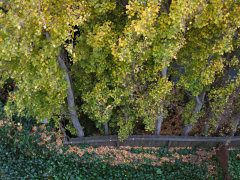
|
These
Poplar trees were among the last remaining trees in such a large inner
courtyard on Nob Hill in San Francisco. Birds such as Robins and House
Finches were fond of these trees because the courtyard was safe and the
trees were tall — offering security to birds non-trusting of humans.
Further, the trees offered a taste of nature to many
dozens of apartments facing the courtyard. They offered beauty and
reduced the volume of unending city noise. Most importantly, the
Poplars, like all large trees, cleaned a great deal of carbon from the
air. |
|
In a city, with so many vehicles on the streets and
businesses such as auto repair services polluting the air, big trees are
important to the health of both people and birds alike. But, like it or
not, trees as with all living things, need attention. And therein lies
the rub. It means building owners must spend money on the trees.
Considering that perhaps the great majority of building owners don’t
live in San Francisco, the decision to plant or maintain trees on their
far away properties has everything to do with the bottom line. |
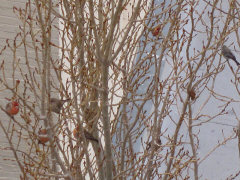
|
During
one cold January 2010 day, House Finches are seen relaxing on the
branches of Poplar trees. They are safe here even though there are small
hawks in the area. Because Poplar trees are thick with small branches,
small birds such as these colorful House Finches can quite easily evade
capture by a hawk or falcon by escaping to the inner branches the hawks
and falcons can’t penetrate. |
|
Notice that the House Finches congregate together as
an additional safety measure. In the event they can’t reach the safety
of thick tree branches when threatened by birds of prey, they fly off in
various directions, cheeping loudly while flying in a lilting manner
designed to help avoid capture.
Such maneuvering in flight, combined with loud
cheeping confuses the enemy and most of the time works to the advantage
of the finches. |
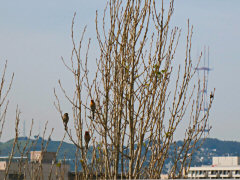
|
As
the Poplar trees begin to bud these House Finches seen on a
particularly beautiful March 16, 2010 day are, along with Robins, busy
preparing nests in which to lay eggs which would soon be arriving by
already pregnant females.
Almost daily we are shown tragedies from around the
world of homes being blown away by wind or burned to the ground along
with the grieving people who are the victims of such events. |
Usually
little or no attention is given to the fate of birds when natural or
human events destroy their neighborhoods. These House Finches, enjoying
the day as they foraged for nest building materials, hadn’t a clue as to
the fate which was to befall them the very next day.
Alas, with the human caused disaster in the Gulf of
Mexico killing all manner of birds and other species of life; perhaps
people are becoming aware of the wanton death of living beings and
destruction of habitat caused by human greed.
|
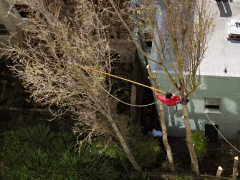
|
The
morning of March 17th the people living around the center courtyard and
the birds preparing nests in the Poplar trees would awaken to the sound
of saws cutting down every tree.
People were seen silently looking at the unfolding
tragedy from their windows and rooftops while the Robins and House
Finches were seen frantically flying over and around the trees being
dismembered. There was enough anguish to go around for both the people
and the birds.
|
The
out-of-town property owner could not be convinced to save just one of
the Poplars for the people of the courtyard to enjoy and the birds to
nest in. The days of a wide variety of birds visiting the courtyard and
nesting in the trees had in a day come to a complete end. |
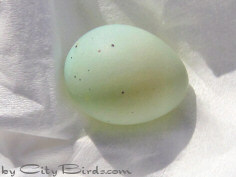
|
A
few days after the Poplar trees were sawed to the ground a female House
Finch appeared at our birdbath and dropped an egg. Although we had
hoped stress had caused an accident, we knew from years of observation
that the female had aborted the egg.
Yes, like humans, House Finches practice abortion.
However, usually the female will only drop an egg (usually from a tree
branch) at the end of the breeding season. |
Once
the female finch has had enough of being pregnant and is tired she will
practice abortion. But the stress of losing the trees right at the
beginning of breeding was too much for her. We carefully placed
the egg in a safe, sunny area hoping against hope that she would return
and accept the egg. |
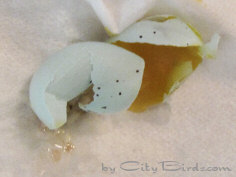
|
To
our amazement the female House Finch returned not long after dropping
the egg. We had great hope she was ready to accept and incubate the egg.
To our great sadness, the female finch went to the
egg and smashed it with her beak. She seemed to be making it clear to us
that she was having nothing to do with the egg. |
A
logistical nightmare had been created. Without the trees in which to
both nest and incubate eggs, she would have to move on. Without the
safety of the thick Poplar branches to protect her young, it was no time
to be a mother.
|
To the Blog Archive
|

